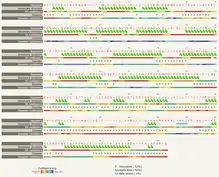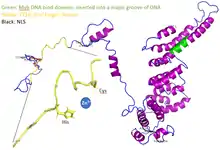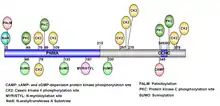ZCCHC18
Zinc finger CCHC-type containing 18 (ZCCHC18) is a protein that in humans is encoded by ZCCHC18 gene. It is also known as Smad-interacting zinc finger protein 2 (SIZN2), para-neoplastic Ma antigen family member 7b (PNMA7B), and LOC644353.[5][6] Other names such as zinc finger, CCHC domain containing 12 pseudogene 1, P0CG32, ZCC18_HUMAN had been used to describe this protein.
| ZCCHC18 | |||||||||||||||||||||||||
|---|---|---|---|---|---|---|---|---|---|---|---|---|---|---|---|---|---|---|---|---|---|---|---|---|---|
| Identifiers | |||||||||||||||||||||||||
| Aliases | ZCCHC18, PNMA7B, SIZN2, zinc finger CCHC-type containing 18 | ||||||||||||||||||||||||
| External IDs | MGI: 1914245 HomoloGene: 121722 GeneCards: ZCCHC18 | ||||||||||||||||||||||||
| |||||||||||||||||||||||||
| |||||||||||||||||||||||||
| |||||||||||||||||||||||||
| Orthologs | |||||||||||||||||||||||||
| Species | Human | Mouse | |||||||||||||||||||||||
| Entrez | |||||||||||||||||||||||||
| Ensembl | |||||||||||||||||||||||||
| UniProt | |||||||||||||||||||||||||
| RefSeq (mRNA) |
| ||||||||||||||||||||||||
| RefSeq (protein) |
| ||||||||||||||||||||||||
| Location (UCSC) | Chr X: 104.11 – 104.12 Mb | Chr X: 136.99 – 137 Mb | |||||||||||||||||||||||
| PubMed search | [3] | [4] | |||||||||||||||||||||||
| Wikidata | |||||||||||||||||||||||||
| |||||||||||||||||||||||||
ZCCHC18 belongs to the ZCCHC12 family or para-neoplastic Ma (PNMA). It is a ligand-dependent nuclear receptor transcription coactivator. Its zinc finger domain is CCHC which binds to zinc ion (see protein section for detail information on CCHC motif).[7]
It is worthwhile to mention that in mammals, PNMA is derived from Ty3/Gypsy long terminal repeat (LTR) retrotransposons and PNMA family encodes the Gag-like protein.[8] Although the full functions remain unknown, most PNMA genes are expressed in brains of macaques and mice.[9] PNMA1, 2 and 3 were found in the serum of patients with paraneoplastic neurological disorders. The family also includes modulator of apoptosis 1, having a role in death receptor-dependent apoptosis.[10]
Gene
Location
ZCCHC18 gene locates at the long arm of X chromosome, loci position Xq22.2. This gene contains 3 exons and 2 distinct gt-ag introns, being transcribed into 3 alternatively spliced mRNAs. However, only one spliced mRNA (NM_001143978.2, 2951 bp) putatively encodes a 403 amino acid protein, whereas the others does not encode proteins.[11]
Gene Neighborhood
Nearby genes include SLC25A53 (on the negative strand) (about 8,000 bit/s upstream) and FAM199X (on the positive strand) (about 50,800 bit/s downstream).[7]
Expression
ZCCHC18 ubiquitously expresses in ovary, brain (cerebellum), endometrium, lymph node, spleen and 22 other tissues in human and other species.[12] Based on RNA-Seq expression data from GTEx (53 tissues from 570 donors), highest median expression is in brain—cerebellum (4.74 RPKM) whereas the total median expression of 67.54 RPKM.[13]
Promoter
Possible transcription binding sites is analyzed by Genomatix,[14] listed in the table below:
| Matrix Family | Detailed Family Information | Anchor position | Strand | Matrix sim. | Sequence |
|---|---|---|---|---|---|
| V$AP1R | MAF and AP1 related factors | 1225 | - | 0.996 | gcacggcgtcAGCAgctcggacgca |
| V$MZF1 | Myeloid zinc finger 1 factors | 1040 | - | 0.995 | agGGGGaagcg |
| V$ZF02 | C2H2 zinc finger transcription factors 2 | 1916 | - | 0.993 | caccccgCCCCcgacacccaaca |
| V$CAAT | CCAAT binding factors | 1368 | - | 0.991 | gcggCCAAtcagcgg |
| V$SORY | SOX/SRY-sex/testis determining and related HMG box factors | 307 | + | 0.989 | gggtcaCAAAgggctgtcgaaat |
| V$ZFHX | Two-handed zinc finger homeodomain transcription factors | 1029 | + | 0.988 | acgctGTTTcccc |
| V$ZTRE | Zinc transcriptional regulatory element | 503 | - | 0.984 | gagGGAGggggtgagga |
| V$ZTRE | Zinc transcriptional regulatory element | 2165 | + | 0.984 | gcgGGAGggcaggaggc |
| V$NEUR | NeuroD, Beta2, HLH domain | 774 | + | 0.982 | ctccCATCtggcttt |
| V$MIZ1 | Myc-interacting Zn finger protein 1 | 480 | + | 0.981 | tcagcCCTCtc |
| V$IKRS | Ikaros zinc finger family | 1483 | + | 0.98 | ccttGGGAaccgt |
| V$CEBP | Ccaat/Enhancer Binding Protein | 713 | + | 0.979 | tcatcTGTGaaatgg |
| V$GATA | GATA binding factors | 724 | + | 0.974 | tggaGATAatggt |
| O$INRE | Core promoter initiator elements | 1407 | + | 0.972 | tcTCAGtcgcc |
| V$AP2F | Activator protein 2 | 1281 | - | 0.936 | ctgGCCGgcgggccg |
| V$MAZF | Myc associated zinc fingers | 1126 | + | 0.904 | cccgGAGGagagc |
Orthologs
Orthologs of ZCCHC18 can be found in most Chordata (Mammalia, Amphibian, Reptilian, Osteichthyes, but not in Arthropod, Aves, Chondrichthyes), Echinoderm, and Cnidarian but not in Fungus, Plant, Ciliates, Archaea, nor Bacteria.
Paralogs
Eight possible paralogs of ZCCHC18 were identified in Homo sapiens.
| Gene Name | Accession | Coverage | E-Value | Sequence Identity % |
|---|---|---|---|---|
| PNMA7A (ZCCHC12) | NP_776159.1 | 99% | 0 | 84% |
| PNMA3 | NP_001269464.1 | 91% | 4.00E-40 | 29% |
| PNMA1 | NP_006020.4 | 45% | 3.00E-39 | 43% |
| PNMA5 | NP_443158.1 | 47% | 4.00E-39 | 41% |
| PNMA2 | NP_009188.1 | 48% | 5.00E-39 | 41% |
| PNMA6A (PNMA6C) | NP_116271.3 | 52% | 6.00E-27 | 38% |
| PNMA6E | NP_001338223.1 | 48% | 4.00E-21 | 36% |
| PNMA6F (PNMA6BL) | NP_001341909.1 | 54% | 1.00E-18 | 33% |
Note: PNMA4 (aliases: modulator of apoptosis 1, MOAP1) does not appear to be similar to ZCCHC18 (the identity and similarity between ZCCHC18 and MOAP1 are 15% and 32.1%, respectively).
Transcript
Splice Variants

Including 5’-UTR and 3’-UTR, ZCCHC18 spans from chrX:104,112,526-104,115,846 with a total of 3,321 base pairs (bps) (5’-UTR: 1206 bit/s and 3’-UTR: 523 bit/s). It contains 3 exons and 2 distinct gt-ag introns, being transcribed into 3 alternatively spliced mRNAs. However, only one spliced mRNA (NM_001143978.2, 2951 bit/s) putatively encodes a protein with 403 amino acids (coding region: hg38 chrX:104,114,112-104,115,323, total 1,212 bit/s), whereas others do not encode proteins.[7][16][17]
Comparing to human ZCCHC18 mRNA which there are 3 isoforms, there are 7 isoforms of Zcchc18 in mouse (Mus musculus), and no isoform in cat (Felis catus) and leopard (Panthera pardus).
Protein
ZCCHC18 is a human protein with 403 amino acids in length and has a predicted molecular weight of 45,160 daltons. Its basal isoelectric point is 7.02 (unphosphorylated state), and isoelectric point decreased with increased number of residues being phosphorylated. The common sequences of ZCCHC18 include KRED and LVIFM. It is generally electroneutral (there are no positive or negative charge clusters or segments) with no high hydrophobic segments.
Secondary Structure

Secondary structure prediction of a not well-characterized protein can be performed by using PRBI database,[18] Phyre2,[15] and I-TASSER.[19] The secondary structure prediction of ZCCHC18 was analyzed by Phyre2.
Tertiary Structure
The tertiary structure was predicted by I-TASSER[19] in the attempt to optimize C-score, TM-score, and cluster density. The predicted ZCCHC18 tertiary structure is shown in the figure..
Post-Translational Modifications


The predicted post-translational modifications (PTMs) is obtained by using Prosite,[20] and many other tools.[21][22][23][24][25][26][27] The key post translation modifications are summarized here.
Subcellular Localization
ZCCHC18 primary locates in the nucleus (appearance to be nuclear speck, a discrete extra-nucleolar subnuclear domain, under immunofluorescence microscopy).[28]
Function
Although the exact function of ZCCHC18 is still not fully known, the basic amino acid sequence of the zinc finger (Znf) CCHC-type protein can be well characterized as conservatively spaced cysteine and histidine.[8] The Cys and His residues is completely conserved at position 1 (Cys), 4 (Cys), 9 (His), and 14 (Cys) [as the first Cys of the sequence labeled as Cys (1)]. Conservatively substituted glycines occur at position 5 and 8, and aromatic or hydrophobic amino acids are at positions 2 (or 3) and 10. This motif is often expressed as Cys-X2-Cys-X4-His-X4-Cys.
The structure of zinc finger domains enables the protein to make tandem contact with target molecules through multiple finger-like protrusions. These domains can bind to zinc or other metals such as iron, or even no metal (stabilizing through salt bridges).[29] The exact mechanism for how the Znf domain of ZCCHC18 work is still unknown.
Interacting Proteins
ZCCHC18 can possibly interact with the intracellular domain of EGFR. This report was based on the two protein-protein interaction (PPI) approaches, the membrane yeast two-hybrid (MYTH) and the mammalian membrane two-hybrid (MMTH), to map the PPIs between human receptor tyrosine kinases (RTKs) and phosphatases.[30]
Clinical Significance
Disease Association

By examining RNA-seq data from The Cancer Genome Atlas (TCGA),[31] glioma has enhanced RNA expression (median 1.9 FPKM [Fragments Per Kilobase of exon per Million reads]) whereas other cancer types only have minimal expression (median expression level lower than 0.5 FPKM). In terms of the ZCCHC18 protein expression, squamous and basal cell carcinomas, and cases of urothelial cancers exhibited moderate to strong cytoplasmic immunoreactivity. Remaining cancer cells were weakly stained or negative. While interrogating 4440 tumor samples from 15 cancer types from TCGA,[14] the analysis showed a vary protein mutation frequency in different cancer types. ZCCHC18 mutation happened frequently in endometrial cancer (~ 2.4%), followed by bladder cancer (~0.8%), head/neck carcinoma (~0.4%), ovarian cancer (~0.4%), and breast cancer (<0.2%).
Genetic Testing
Currently, Fulgent Genetics is the only commercial company provides the genetic testing for deletion or duplication of ZCCHC18 through sequence analysis of the entire coding region (Next-Generation Sequencing) for possible diseases caused by mutations on this particular gene that are inherited from a parent's genome. However, the clinical validity and utility have not been proven yet.[32]
References
- GRCh38: Ensembl release 89: ENSG00000166707 - Ensembl, May 2017
- GRCm38: Ensembl release 89: ENSMUSG00000031428 - Ensembl, May 2017
- "Human PubMed Reference:". National Center for Biotechnology Information, U.S. National Library of Medicine.
- "Mouse PubMed Reference:". National Center for Biotechnology Information, U.S. National Library of Medicine.
- "ZCCHC18 Gene". GeneCards.
- "Gene: ZCCHC18 (ENSG00000166707) - Summary - Homo sapiens - Ensembl genome browser 91". useast.ensembl.org. Retrieved 2018-02-22.
- "Human Gene ZCCHC18 (ENST00000611638.4) Description and Page Index". genome.ucsc.edu. Retrieved 2018-04-30.
- Summers MF (January 1991). "Zinc finger motif for single-stranded nucleic acids? Investigations by nuclear magnetic resonance". Journal of Cellular Biochemistry. 45 (1): 41–8. doi:10.1002/jcb.240450110. PMID 2005183.
- Takaji M, Komatsu Y, Watakabe A, Hashikawa T, Yamamori T (December 2009). "Paraneoplastic antigen-like 5 gene (PNMA5) is preferentially expressed in the association areas in a primate specific manner". Cerebral Cortex. 19 (12): 2865–79. doi:10.1093/cercor/bhp062. PMC 2774394. PMID 19366867.
- Iwasaki S, Suzuki S, Pelekanos M, Clark H, Ono R, Shaw G, Renfree MB, Kaneko-Ishino T, Ishino F (October 2013). "Identification of a novel PNMA-MS1 gene in marsupials suggests the LTR retrotransposon-derived PNMA genes evolved differently in marsupials and eutherians". DNA Research. 20 (5): 425–36. doi:10.1093/dnares/dst020. PMC 3789554. PMID 23704700.
- "1000 Genomes Browser". www.ncbi.nlm.nih.gov. Retrieved 2018-02-22.
- "ZCCHC18 zinc finger CCHC-type containing 18 [Homo sapiens (human)] - Gene - NCBI". www.ncbi.nlm.nih.gov. Retrieved 2018-04-30.
- "Gene expression for ZCCHC18 (ENSG00000166707.6)". GTEx Portal. 2018-04-30.
- "Genomatix: Human ZCCHC18". www.genomatix.de. Retrieved 2018-05-10.
- Kelley, Lawrence. "PHYRE2 Protein Fold Recognition Server". www.sbg.bio.ic.ac.uk. Retrieved 2018-05-10.
- [email protected], Danielle Thierry-Mieg and Jean Thierry-Mieg, NCBI/NLM/NIH. "AceView: Gene:ZCCHC18, a comprehensive annotation of human, mouse and worm genes with mRNAs or ESTsAceView". www.ncbi.nlm.nih.gov. Retrieved 2018-04-30.
- "Gene: ZCCHC18 (ENSG00000166707) - Summary - Homo sapiens - Ensembl genome browser 92". useast.ensembl.org. Retrieved 2018-04-30.
- UCBL, Institut de Biologie et Chimie des Proteines - UMR5086 - CNRS -. "NPS@ : GOR4 secondary structure prediction". npsa-prabi.ibcp.fr. Retrieved 2018-05-10.
- "I-TASSER server for protein structure and function prediction". zhanglab.ccmb.med.umich.edu. Retrieved 2018-05-10.
- "Prosite: Human ZCCHC18".
- "NetAcet 1.0 Server". www.cbs.dtu.dk. Retrieved 2018-05-10.
- "SUMOplot™ Analysis Program | Abgent". www.abgent.com. Retrieved 2018-05-10.
- "GPS-SUMO: Prediction of SUMOylation Sites & SUMO-interaction Motifs". sumosp.biocuckoo.org. Retrieved 2018-05-10.
- "CSS-Palm - Palmitoylation Site Prediction". csspalm.biocuckoo.org. Retrieved 2018-05-10.
- ":::BDM-PUB - Prediction of Ubiquitination Sites with Bayesian Discriminant Method:::". bdmpub.biocuckoo.org. Retrieved 2018-05-10.
- "ExPASy - Sulfinator". web.expasy.org. Retrieved 2018-05-10.
- "MYR Prediction Server". mendel.imp.ac.at. Retrieved 2018-05-10.
- "ZCCHC18 - Zinc finger CCHC domain-containing protein 18 - Homo sapiens (Human) - ZCCHC18 gene & protein". www.uniprot.org. Retrieved 2018-05-10.
- EMBL-EBI, InterPro. "Zinc finger, CCHC-type (IPR001878) < InterPro < EMBL-EBI". www.ebi.ac.uk. Retrieved 2018-02-22.
- Yao Z, Darowski K, St-Denis N, Wong V, Offensperger F, Villedieu A, Amin S, Malty R, Aoki H, Guo H, Xu Y, Iorio C, Kotlyar M, Emili A, Jurisica I, Neel BG, Babu M, Gingras AC, Stagljar I (January 2017). "A Global Analysis of the Receptor Tyrosine Kinase-Protein Phosphatase Interactome". Molecular Cell. 65 (2): 347–360. doi:10.1016/j.molcel.2016.12.004. PMC 5663465. PMID 28065597.
- "Search: ZCCHC18 - The Human Protein Atlas". www.proteinatlas.org. Retrieved 2018-05-10.
- "ZCCHC18 - Tests - GTR - NCBI". www.ncbi.nlm.nih.gov. Retrieved 2018-02-22.



